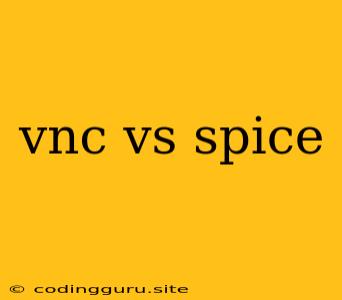VNC vs SPICE: Which Remote Desktop Protocol is Right for You?
Choosing the right remote desktop protocol can significantly impact your remote access experience. Two popular choices are VNC (Virtual Network Computing) and SPICE (Simple Protocol for Independent Computing Environments). While both protocols offer remote desktop functionality, they differ in features, performance, and suitability for specific use cases. This article explores the key differences between VNC and SPICE, helping you understand which protocol best suits your needs.
What is VNC?
VNC is a widely adopted remote desktop protocol that allows users to control a remote computer's desktop environment over a network connection. It works by capturing the remote desktop's screen and transmitting it as a series of images to the client machine. VNC uses a client-server architecture, where a VNC server runs on the remote computer and a VNC client on the user's local machine.
What is SPICE?
SPICE, developed by Red Hat, is a remote desktop protocol designed for virtualized environments. Unlike VNC, SPICE focuses on providing a more efficient and feature-rich experience for virtual machines. It integrates directly with virtualization software like QEMU and KVM, leveraging virtualization-specific features for enhanced performance.
Key Differences Between VNC and SPICE:
1. Performance:
- VNC: VNC's reliance on capturing and transmitting full-screen images can lead to performance issues, especially over low-bandwidth connections or with high-resolution displays.
- SPICE: SPICE utilizes smart compression techniques and optimized protocols, resulting in a more responsive and fluid user experience, particularly when accessing virtual machines.
2. Features:
- VNC: VNC offers basic remote desktop functionality, including keyboard and mouse input, clipboard sharing, and file transfer.
- SPICE: SPICE provides a richer set of features, such as:
- Hardware Passthrough: Allows virtual machines to access physical hardware devices like USB peripherals directly.
- Input Redirection: Offers support for specialized devices like graphics tablets and audio devices.
- Advanced Graphics Support: Enables high-resolution displays and 3D graphics acceleration.
- Guest Agent Integration: Allows for enhanced guest operating system management and monitoring.
3. Security:
- VNC: VNC's security relies heavily on encryption, which needs to be configured properly. While modern VNC implementations offer encryption, older versions might lack robust security measures.
- SPICE: SPICE is designed with security in mind, offering built-in encryption and authentication mechanisms. It also leverages virtualization security features for enhanced protection.
4. Compatibility:
- VNC: VNC is widely supported across various platforms, making it compatible with Windows, macOS, Linux, and other operating systems.
- SPICE: SPICE is primarily designed for virtualized environments and works best with virtualization platforms like QEMU/KVM and Xen.
5. Complexity:
- VNC: VNC is relatively easy to configure and use, thanks to its straightforward client-server architecture.
- SPICE: SPICE's integration with virtualization software might require more technical knowledge to configure and utilize effectively.
Choosing the Right Protocol:
- VNC: Choose VNC if you need a simple and widely compatible remote desktop solution for accessing a physical computer over a network connection. It's suitable for basic remote control tasks, but performance might be a concern over low-bandwidth connections.
- SPICE: Opt for SPICE if you are working with virtual machines and require advanced features, enhanced performance, and robust security. SPICE is ideal for accessing virtual desktops with demanding graphics, accessing physical hardware devices, and utilizing advanced virtualization features.
Conclusion:
Both VNC and SPICE offer valuable remote desktop solutions, each with its own strengths and weaknesses. VNC is a proven and widely supported protocol, while SPICE is a more modern and feature-rich option specifically designed for virtualized environments. The choice between the two depends on your specific needs, environment, and priorities. Consider your workload, bandwidth limitations, security requirements, and compatibility needs when deciding which protocol aligns best with your remote access goals.
